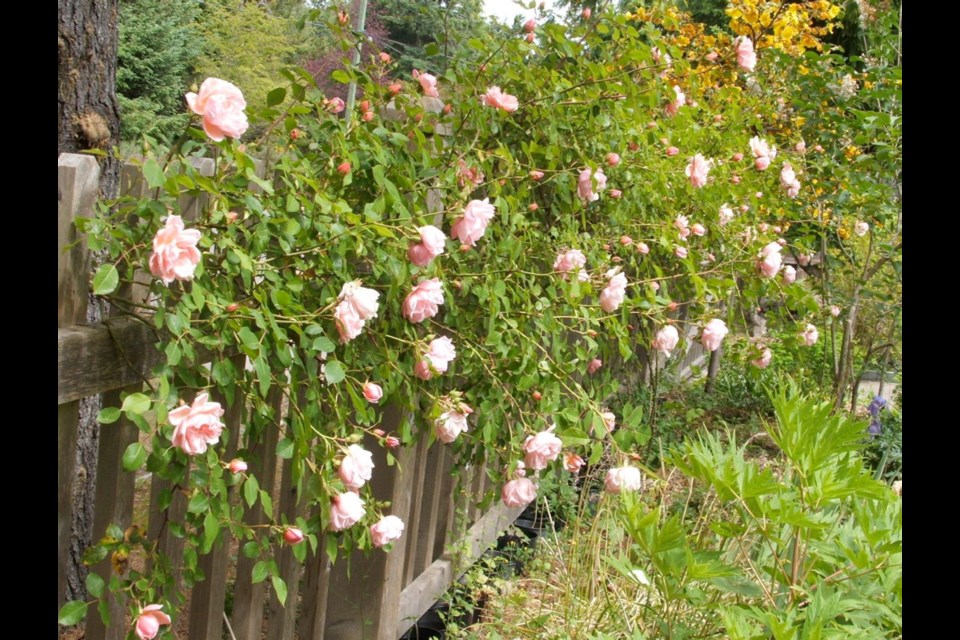Dear Helen: Can I prune my roses now?
S.N.
That depends on the type of rose. Leave the main pruning of bush roses until late winter, ideally as growth buds show the first signs of swelling. Restrict pruning in the fall to shortening over-long canes prone to being whipped about and damaged or broken in winter winds.
Among climbing roses there are two main types. Ramblers and climbing old roses that flower only once, most commonly in June, are pruned after flowering, in July. They flower mainly on the previous season’s growth. Pruning consists of removing some of the oldest (thickest) canes and shortening remaining canes enough to keep the plant in bounds.
I prune my repeat-flowering modern climbers in late autumn, starting with the removal of the oldest canes. I arrange and secure the remaining canes to the support in a fan shape, as close to the horizontal as possible for best flowering, and shorten them to fit the support. Side shoots off these main canes are shortened to leave just three buds.
By December, remove all rose leaves still clinging to the plants. Clean up well under and around the plants and plan to mulch early in the spring.
Dear Helen: I love the clumps of bearded iris in my garden. I have several that are re-bloomers. When do I divide the clumps, and how?
H.T.
To maintain bearded (German) irises in good health and optimal flowering, the clumps should be divided every few years. Depending on the plants themselves and their growing conditions, this can be anywhere from 2 to 5 years. For most, every three years is about right. Crowded clumps and diminished bloom are indications that it’s time for renewal.
The ideal time for lifting, dividing and replanting these irises is right after flowering, in July or August. This gives ample time for new roots to become well established before the arrival of cold, wet weather.
I would not take a chance on dividing and replanting now. These irises prefer soil that is on the dry side. A late October planting would mean that healthy rooting would be compromised by cold, wet conditions.
When you do divide and replant, lift each clump carefully to avoid damage to the rhizomes. If the soil is dry, water the day before to make the lifting easier. Separate the clumps into divisions, each with at least one fan of leaves.
Cut the leaves back by around a half, making clean cuts with sharp scissors, and trim back any overlong roots. Trimming back the leaf fans reduces transpiration from the foliage and helps newly planted divisions to settle in. Check for damage, such as soft spots, on the rhizomes and discard any dubious ones.
Choose a planting site in full or nearly full sun, with a rich, loamy, pH neutral (not acid) soil that drains quickly of excess moisture. I form a ridge in each planting hole, so that I can settle the horizontal rhizome atop the ridge and arrange the roots down the sides before firming in the plant. The rhizome should end up just barely showing at the soil surface.
Avoid over-watering bearded irises.
Garden Events
View Royal meeting. The View Royal Garden Club will meet this evening (Wednesday, Oct. 23) at 7:30 p.m. in Wheeley Hall, behind Esquimalt United Church, 500 Admirals Rd. Entrance is off Lyall St. Master gardener Jennifer Kolot will discuss deer-proof plants and strategies for dealing with the animals in “Deer?! . Oh Dear!” There will be a judged mini-show and a sales table with plants and garden items. Non-member drop-in fee $5. viewroyalgardenclub.wordpress.com.
Family harvest festival. The Horticulture Centre of the Pacific (HCP), 505 Quayle Rd. in Saanich, is hosting its annual Family Harvest Festival on Saturday, Oct. 26, from 10 a.m. to 2 p.m. The festival features family-friendly activities for all ages. Details at hcp.ca.
Learning about plants. The next session in the Plant Identification and Culture series at HCP will be on Saturday, Oct. 26, 1 to 4 p.m. This is an ongoing, monthly course that can be joined at any time. In each session Diane Pierce introduces 25 new plants, with descriptions, preferred growing conditions, landscape uses and maintenance. Cost to HCP members per session is $35, others $45. Cost for 12 sessions: members $350, others $450. To register call 250-479-6162.
Chrysanthemum meeting. The Victoria Chrysanthemum Society will meet at 2 p.m. on Saturday, Oct. 26, at 1647 Chandler Ave. The discussion for the afternoon will be on preparing plants for winter.


